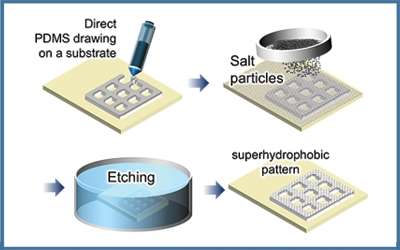Environment-friendly hydrophobic coating made with salt particles

Superhydrophobic surfaces have attracted global attention due to their water-repellant characteristics and myriad number and variety of applications. A team of researchers with the Department of Mechanical Engineering at Pohang University of Science and Technology (POSTECH), led by Professor Dong Sung Kim and comprised of Research Professor Donghwi Choi and 4th year undergraduate student Jaewon Yoo, has found an elegant, cost-effective, and environmentally friendly method of applying a superhydrophobic layer to objects by using commercially available salt particles, polydimethylsiloxane (PDMS), and water.
In nature, one can observe such ultrahydrophobicity on a Lotus leaf. The leaf has microscopic protrusions on its surface which minimizes adhesion. As a result, water droplets along with any dirt particles on the surface simply roll right off the leaf. This effect is appropriately referred to the "lotus effect."
There have been numerous research into applying the "lotus effect" to other surfaces via simulating similar micro- and nanoscopic surface architectures. Anti-icing, anti-sticking, and self-cleaning characteristics are but a few of the many real-world applications of superhydrophobic surfaces. However, while the idea of a stain repellent fabric or a self-cleaning building is revolutionary, existing methods of applying a superhydrophobic layer required complicated procedures with exorbitant equipment costs and/or harsh chemicals.
Prof. Kim's research team has successfully overcome these barriers by utilizing a salt-dissolution-assisted etching process. Taking advantage of the fact that salt readily dissolves in water, the team exposed a salt-particle-embedded PDMS surface to an aqueous environment. The remaining PDMS surface becomes roughened with micro/nano-hierarchical topography which satisfy the standards of superhydrophobic surfaces. Furthermore, this elegant process can readily be applied to large or three-dimensional surfaces.
This remarkable result was recently published in Applied Surface Science—the preeminent SCI level academic journal in the field. What is even more remarkable is the fact that Mr. Yoo, an undergraduate student, was one of the two main authors of this work.
Provided by Pohang University of Science & Technology

















